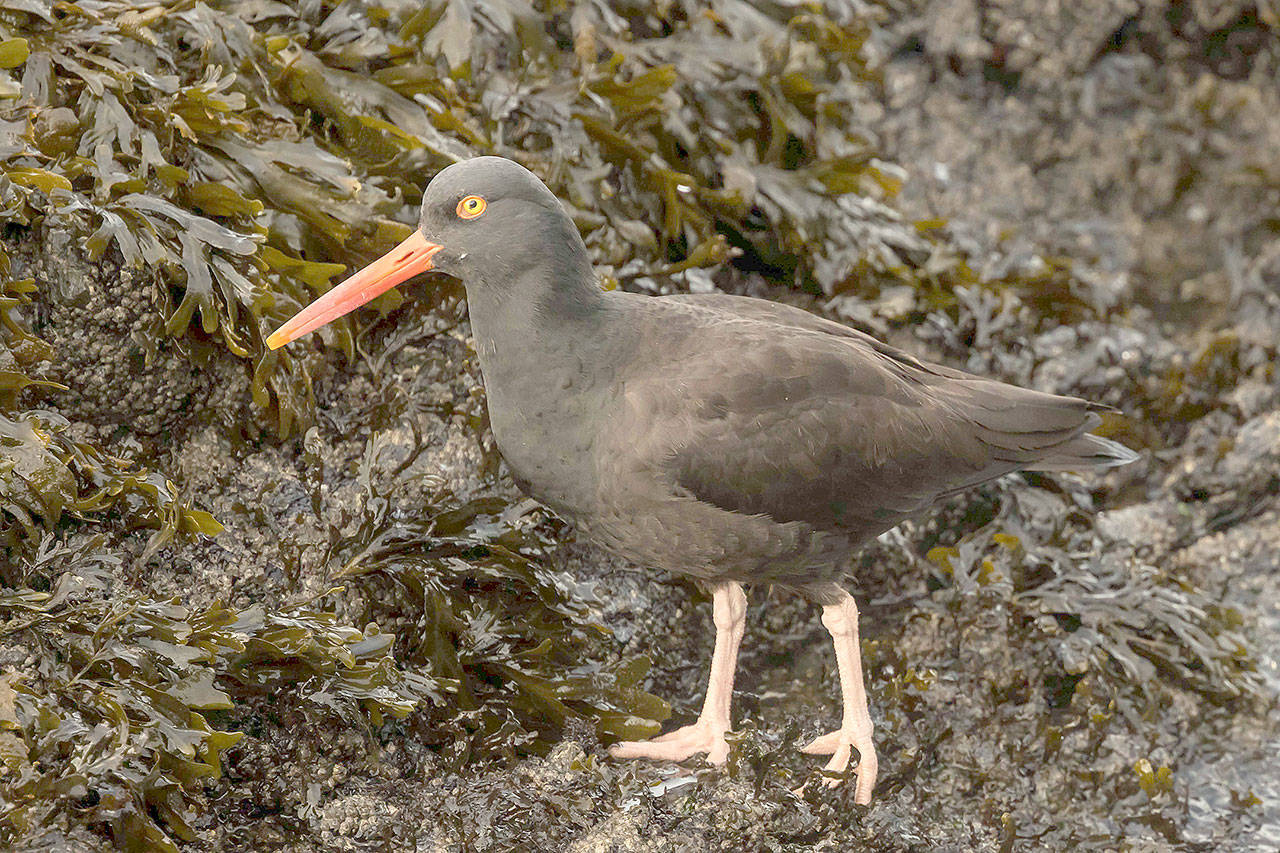By Dianna Moore
Grays Harbor Audubon
Photo by Gregg Thompson
If you have never seen one of these birds, you will not soon forget your first sighting; they are so striking in color and sound they leave a lasting impression. They have what some call “personality”, with individual birds acting almost like a kid in a playground…all noise and energy. They are so much fun to watch. Gregg Thompson’s excellent photo shows one in a short moment of quiet, studying Gregg himself. Look quickly; it won’t last!
General description: Black Oystercatchers are crow-sized birds of the rocky parts of our coast, and can be found in appropriate habitat any time of the year. Their sturdy build, large orange bill, orange eye-ring, and no-nonsense pink legs made for heavy-duty jumping around on the rocks sets them apart from most other birds of our shoreline. They are 10.5 to 18.5 inches long, with a wing span of 32 inches, and weighing 1.4 pounds. They spend most of their time climbing around on the rocks at the splash zone, so be prepared to either climb out on the rocks, and possibly get splashed yourself, or watch from a distance through a scope.
Habitat: This bird is native to the Pacific coast, so it can be found on rocks, islands, and jetties throughout our region. It is classified as “uncommon” all months of the year, so you may have to spend some time trying to find them, but they are worth the effort.
Behavior: Found in pairs or small-to-medium flocks, they can be seen best at low tide, foraging for prey in the rocks near the waves where the newly exposed underside of the rocks harbor their favorite foods. During rough seas they can gather into larger groups in a sheltered site. When disturbed they take off with much yelping and whistling. They are also known to indulge in loud and boisterous breeding displays.
Diet: Black Oystercatchers feed on a wide range of shellfish, worms and fish, but prefer mussels and limpets which their heavy-duty bill allows them to pry off the rocks above and even below the surface of the water (they are also good swimmers and divers). A quick stab to the abductor muscle of their prey when the shell is open disables the ability of the prey to close its shell, and the birds bill can easily pull the prey out of its shell.
Nesting: Black Oystercatchers form long-term pair bonds, defending their nesting and feeding territories year-round, and returning to the same territory year after year. They nest in non-forested area, often on rocky island beaches with unobstructed views, above the high tide line. Both birds build a small scrape of bits of shells and small rocks. The female lays two to three eggs. If a nest has more than four eggs it is most likely a “dump” nest, where more than one female has laid her eggs in the same nest. Both parents share incubation duties for the next three and one-half to four weeks. Unlike other shorebirds, the young cannot feed themselves, so both parents feed the young until they are able to fly and forage on their own, at about five weeks. The parents continue to help with the food until the young are competent on their own.
Migration: There is no real migration, but the Oystercatchers may move around within their general nesting/feeding territories.
Conservation status: It is estimated there are 6,900 to nearly 11,000 Black Oystercatchers and over half are found in Alaska. slightly less than half in British Columbia, about 400 in the state of Washington, and a few hundred are scattered down the coast of Oregon, California, and the Baja Peninsula. Although the population has not significantly changed. they have a fairly specialized habitat and are highly vulnerable to human disturbance, oil spills, and the pollution of the inter-tidal zone.
When and where to find on Grays Harbor: Black Oystercatchers can be seen year-round but are hard to find. The best bets are the rocks around the harbor, the jetties, and the rocky shoreline north of Moclips. I urge you to make the effort to find these spectacular and personable birds for yourself. They are worth it.


